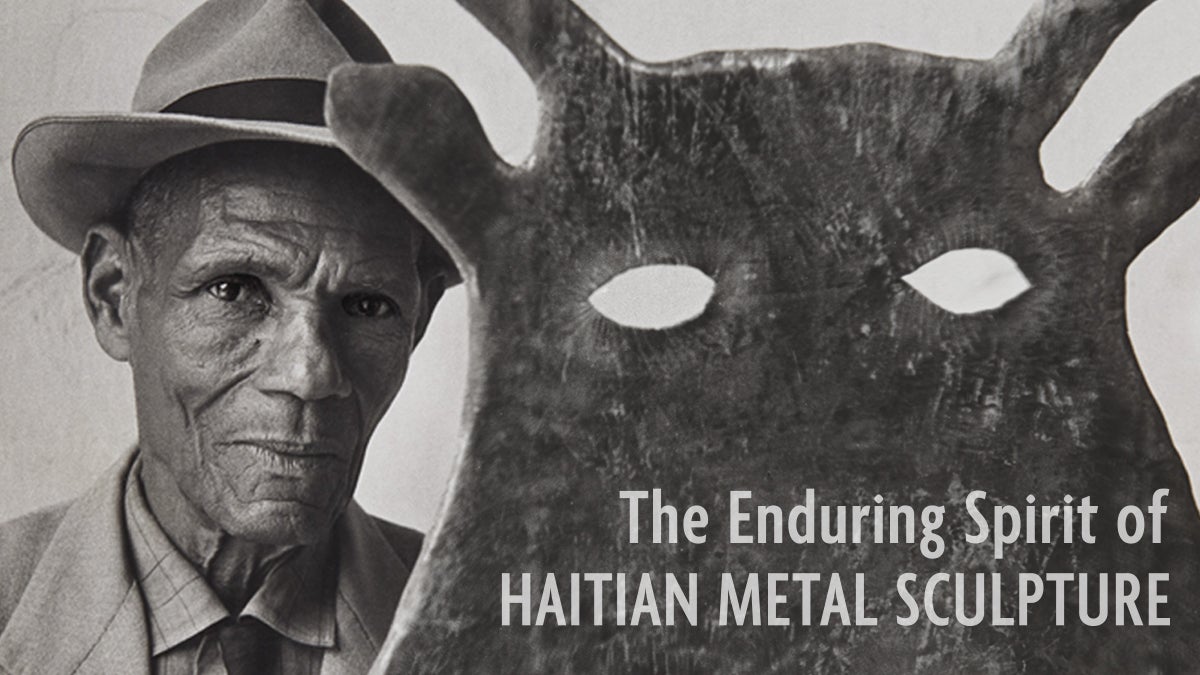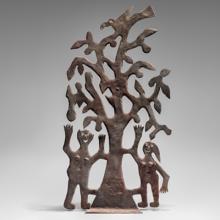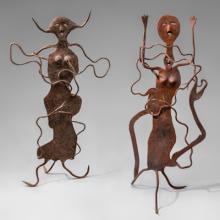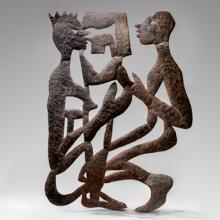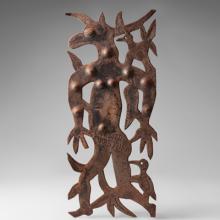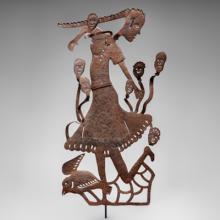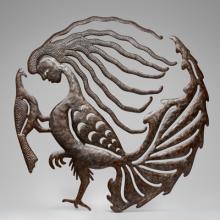The Enduring Spirit of Haitian Metal Sculpture
The Enduring Spirit of Haitian Metal Sculpture
Haiti has long celebrated a rich artistic and cultural heritage. Georges Liautaud (1899–1991) ignited the Haitian metal sculpture movement in the 1950s in Croix-des-Bouquets, Haiti. A blacksmith by trade, he fashioned crosses for public cemeteries before creating more elaborate cut-metal works. Liautaud disseminated the distinctly Haitian art form to emerging artists, such as Murat Brièrre (1938–88) and the Louisjuste brothers, Sérésier, Janvier, and Joseph (1940–89). They, in turn, taught others in Croix-des-Bouquets, including Gabriel Bien-Aimé (b. 1951) and Serge Jolimeau (b. 1952), Haiti’s two leading metal sculptors working today.
Discarded steel oil drums have historically served as the base material for Haitian metal artists. The drums’ lids are cut open with a chisel and hammer and a long vertical split is made along the side of the drums. The interiors are filled with dried sugarcane or grass and lit on fire to remove any grime; once cool, the drums are flattened into sheets. Designs are chalked on; pieces are then cut and sculpted using only hand tools and further enhanced by hammering, embossing, cutting holes, and bending the metal. Sculptures reflect everyday life portraits, imaginative themes, and motifs of Haitian Vodou, an African Diasporic religion. Some of the many forms that appear include angels and winged creatures, mermaids and other aquatic figures, musical bands, animals, and earthly, paradisiacal scenes.
Haitian sculpture and painting flourished in the mid-twentieth century. U.S. artist DeWitt Peters (1902–66) helped establish Le Centre d’Art in Port-au-Prince in 1944 with several prominent Haitian artists and intellectuals, such as architect Albert Mangonès (1917–2002) and painter Georges Remponeau (1916–2012), to support Haitian artists. Despite facing the tremendous obstacle of rebuilding after the center’s destruction during the 2010 earthquake, Le Centre d’Art continues to nurture and promote Haitian art, serving as an art school, gallery, and museum.
The first free Black Republic in the Americas, Haiti was founded by a successful revolution formed by its African-descended self-emancipators in 1804. Despite facing continual social and political turmoil in addition to natural disasters, Haitian metal artists persevere. Noailles, a small town in the Port-au-Prince suburb of Croix-des-Bouquets, has served as the center of the Haitian metal art form. Until recently, this small artistic community was known for the melodic sound of hammering metal that emanated from the dozens of cooperative workshops and storefronts that lined nearly one square mile. In recent years, incessant gang activity has plagued Croix-des-Bouquets, forcing artists to relocate and create works elsewhere. This exhibition honors some of Haiti’s most important metal sculptors, including Liautaud, Brièrre, the Louisjuste brothers, Bien-Aimé, and Jolimeau whose work reflects the enduring spirit of Haiti.
Special thank you to members of the Haitian Art Society—Anthony Fisher, Larry Kent, and Susan Tselos, for making this exhibition possible, and to Dr. Kyrah Malika Daniels for providing her scholarly expertise.
@SFOMuseum
#HaitianMetal
[image]
Georges Liautaud c. 1965
Photograph by William Grigsby
Croix-des-Bouquets, Haiti
Courtesy of the Cavin-Morris Gallery
© Randall Morris
R2023.1004.001
© 2023 by San Francisco Airport Commission. All rights reserved.
